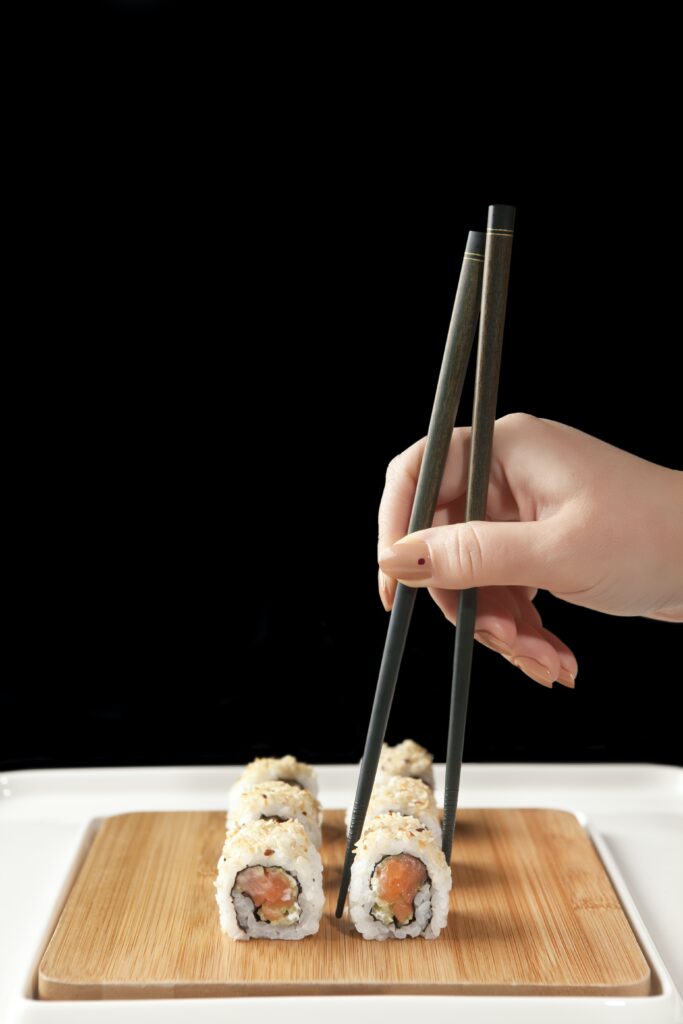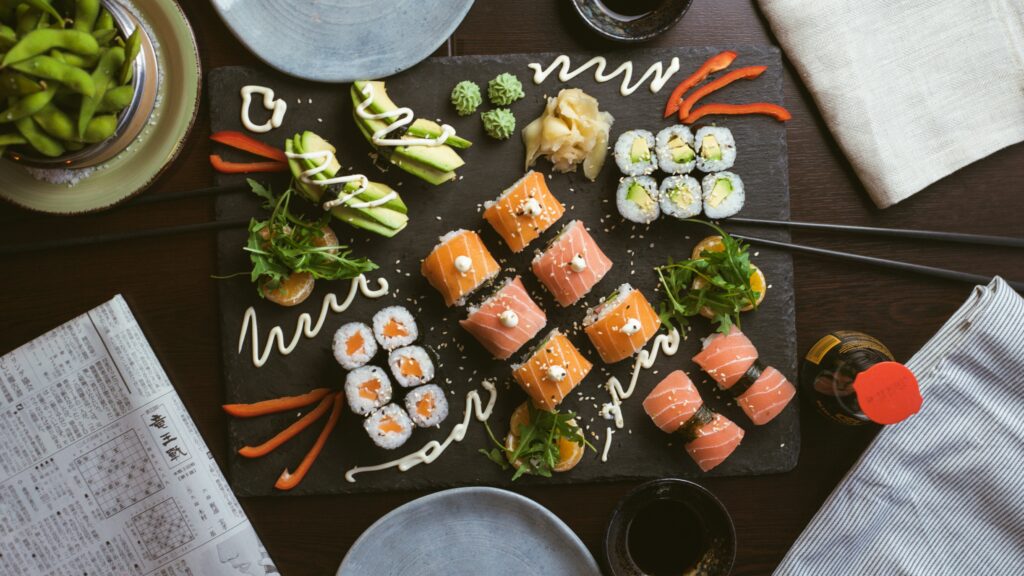Sushi, a beloved Japanese delicacy, is a culinary art form that combines rice, vegetables, and raw or cooked fish into a delectable bite-sized package. In this article, we will explore the different types of sushi, including nigiri, maki, and temaki, each with their own unique ingredients and preparation methods. Nigiri and sashimi, which feature raw fish, are often touted as healthier options, offering potential benefits for gut health, immune system function, and heart health. Additionally, the use of nori, a nutrient-rich seaweed, adds further nutritional value to sushi. However, it is essential to be mindful of potential risks associated with sushi consumption, such as high sodium intake and refined carbohydrates from white rice, as well as the possible exposure to mercury. By choosing sushi with healthier ingredients and practicing proper food safety measures, individuals can continue to enjoy this delightful culinary experience.

Nigiri
Definition
Nigiri sushi is a traditional Japanese dish consisting of bite-sized portions of sushi rice topped with various ingredients. The word “nigiri” translates to “hand-pressed,” which refers to how the sushi rice is formed by hand and then topped with fish or other toppings. Nigiri sushi is typically served at sushi restaurants as part of a sushi platter or as individual pieces.
Ingredients
The key components of nigiri sushi are the sushi rice and the fish toppings. The sushi rice is made by seasoning cooked rice with a mixture of rice vinegar, sugar, and salt. This gives the rice a slightly sweet and tangy flavor and helps to bind the grains together. The fish toppings for nigiri sushi can vary, but commonly include raw or cooked fish such as tuna, salmon, eel, and shrimp. Other ingredients such as roe, tofu, and vegetables can also be used as toppings for nigiri sushi.
Preparation
To prepare nigiri sushi, the sushi chef starts by forming a small amount of sushi rice into a rectangular-shaped mound. The rice is then dipped in soy sauce to give it a glossy appearance and to add flavor. The chef then places a piece of fish or other topping on top of the rice, using a small amount of wasabi to help adhere the two together. The chef takes care to shape the nigiri sushi neatly and evenly, creating a visually pleasing presentation.
Varieties
There are several varieties of nigiri sushi, each with its own unique characteristics. Traditional nigiri sushi consists of a single piece of fish or topping over a mound of sushi rice. Gunkanmaki, also known as “battleship roll,” is a type of nigiri sushi that features a strip of nori seaweed wrapped around the rice, allowing for toppings like roe or sea urchin to be held securely. Chirashizushi, on the other hand, is a style of nigiri sushi where the rice and toppings are mixed together and served in a bowl, creating a more casual and colorful presentation.

Maki
Definition
Maki sushi, also known as sushi rolls, are cylindrical-shaped sushi made by rolling together sushi rice, fillings, and seaweed. The word “maki” translates to “roll” in English, referring to the way the ingredients are rolled together to create the sushi.
Ingredients
The main ingredients used in maki sushi are sushi rice, nori seaweed, and fillings. The sushi rice is the foundation of the maki roll, providing a sticky and flavorful base. Nori seaweed is used to wrap around the rice and fillings, adding a touch of saltiness and a crispy texture. The fillings for maki sushi can vary, with popular options including raw or cooked fish, vegetables, and even fruit.
Preparation
To prepare maki sushi, a sheet of nori seaweed is laid flat on a bamboo sushi mat. A layer of sushi rice is then spread evenly over the nori, leaving a small border at the top to seal the roll. The fillings are then added on top of the rice in a straight line along the bottom edge of the nori. Using the bamboo mat as a guide, the sushi roll is carefully rolled up, applying gentle pressure to hold the ingredients together. The roll is then cut into bite-sized pieces and presented with precision.
Varieties
There are countless varieties of maki sushi, with different combinations of fillings and presentation techniques. Traditional maki sushi features a single filling, such as cucumber or avocado, wrapped in nori and rice. Futomaki, or “thick roll,” is a larger version of maki sushi that usually contains multiple fillings, including cooked shrimp, tamago (Japanese omelet), and pickled vegetables. Uramaki, also known as an inside-out roll, has the rice on the outside and the nori and fillings on the inside. This style of maki sushi is often topped with sesame seeds or roe for added texture and flavor.

Choosing Healthy Sushi
Low-mercury fish
When choosing sushi, it is important to prioritize low-mercury fish options. Certain types of fish, such as tuna and swordfish, can contain high levels of mercury, which can be harmful to health if consumed in excess. Opting for fish with lower mercury levels, such as salmon or shrimp, is a safer and healthier choice.
Vegetable options
For those who prefer to avoid raw fish or who follow a vegetarian or vegan diet, there are plenty of vegetable options available in sushi. Vegetarian sushi rolls can be made with ingredients like cucumber, avocado, carrot, and radish, providing a refreshing and nutritious alternative to fish-based sushi.
Food safety practices
When consuming raw or undercooked fish, it is important to follow proper food safety practices to minimize the risk of foodborne illnesses. Sushi should be prepared and stored in a clean and well-maintained environment. Additionally, sushi chefs should follow strict hygiene practices, including handwashing and using separate utensils for handling raw and cooked ingredients. It is also recommended to choose reputable sushi restaurants that prioritize food safety and quality.
In conclusion, nigiri and maki sushi are both delicious and versatile types of sushi. Nigiri sushi showcases the simplicity and elegance of raw fish and sushi rice, while maki sushi offers endless possibilities for creative flavor combinations. When choosing sushi, it is important to consider the health benefits and potential risks associated with different ingredients. By selecting low-mercury fish, exploring vegetarian options, and ensuring proper food safety practices, sushi can be enjoyed as a tasty and nutritious meal.
